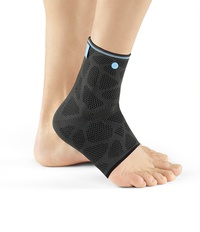Pulled Muscles
Ruptures and tears in muscle fibres
In the realm of orthopedics, a pulled muscle refers to ruptures or tears in the muscle tissue. Our muscles, tendons, and ligaments can sustain injuries similar to how an elastic band can snap (either partially or completely) when put under too much strain.
When a muscle is pulled, overstretching results in minor damage to muscle fibres. When the muscle is torn, the tissue is completely severed. Both can occur either as a result of sudden jerky movements or through overstretching of the muscles without warming up beforehand. If the muscle fibre is torn, entire muscle bundles (a single mass of muscle fibre) can be severed.
Ligamentscan also be pulled or torn. When this happens, it is because overstretching causes the joint capsule (the connective tissue surrounding the joint) or the ligaments in the joint to sustain minor injuries.
When a muscle is pulled or torn, sharp and sudden pain occurs in most cases along with bruising and/or swelling. The symptoms can be traced back to small blood clots, these put pressure on the adjoining tissue, which can cause pain.

How is a Pulled Muscle treated?
For severe cases, the acronym R.I.C.E. is used:
- R is for Rest: The muscle should be rested. If you are in pain, refrain from taking part in any sport for a while.
- I is for Ice: Treat the affected area immediately with cold water, ice, or cold packs to prevent bruising and swelling, which may cause further pain. Be careful not to apply ice directly to the skin.
- C is for Compression: When a muscle is pulled, bruising and swelling can be prevented by using an elastic bandage or an orthopaedic support. Compression should not cause the muscle to be constricted or pinched.
- E is for Elevate: As well as cooling and compression of the affected area(s), elevating it (i.e. raising it up to a higher level than your heart) also helps to prevent serious bleeding, congestion of blood flow, or swelling when a muscle is pulled.
How is a Muscle Tear treated?
Since a tear in a ligament, tendon or muscle is a more serious injury, the R.I.C.E. method above may be used even though it is not sufficient. Different types of treatment are required here, so that the severed parts can grow back together.
In this case, either surgery takes place or orthoses and orthopedic supports are applied directly so that the joint in question is protected and stabilised from the outside (e.g. Dynamics Plus ). After a period of immobilisation, it is important that the patient gradually starts to move the joint or body part again. Depending on how much the affected area has healed, orthoses can be removed so that healing can progress further, little by little.




